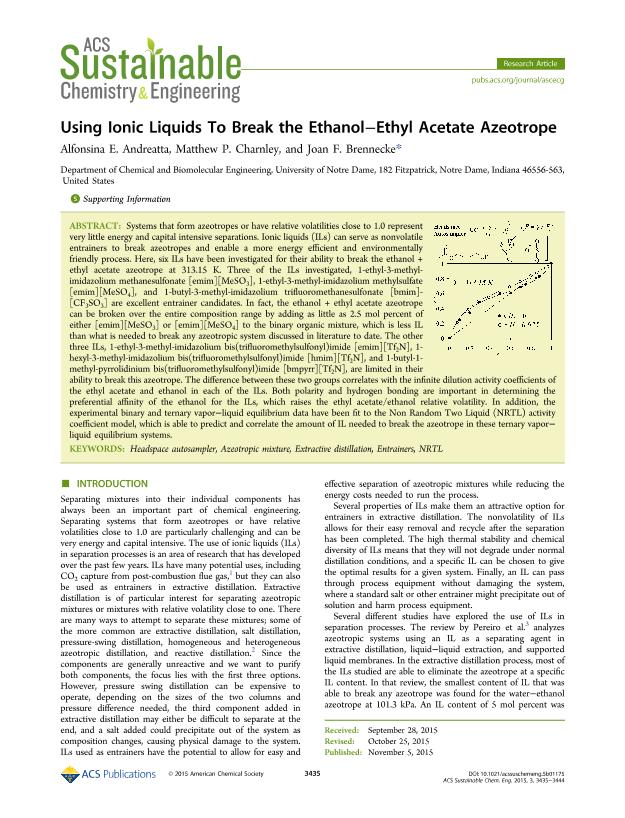Mostrar el registro sencillo del ítem
dc.contributor.author
Andreatta, Alfonsina Ester

dc.contributor.author
Charnley, Matthew P.
dc.contributor.author
Brennecke, Joan F.
dc.date.available
2018-05-24T21:05:46Z
dc.date.issued
2015-11-05
dc.identifier.citation
Andreatta, Alfonsina Ester; Charnley, Matthew P.; Brennecke, Joan F.; Using Ionic Liquids To Break the Ethanol−Ethyl Acetate Azeotrope; American Chemical Society; Sustainable Chemistry & Engineering; 3; 12; 5-11-2015; 3435-3444
dc.identifier.issn
2168-0485
dc.identifier.uri
http://hdl.handle.net/11336/46186
dc.description.abstract
Systems that form azeotropes or have relative volatilities close to 1.0 represent very little energy and capital intensive separations. Ionic liquids (ILs) can serve as nonvolatile entrainers to break azeotropes and enable a more energy efficient and environmentally friendly process. Here, six ILs have been investigated for their ability to break the ethanol + ethyl acetate azeotrope at 313.15 K. Three of the ILs investigated, 1-ethyl-3-methylimidazolium methanesulfonate [emim][MeSO3], 1-ethyl-3-methyl-imidazolium methylsulfate [emim][MeSO4], and 1-butyl-3-methyl-imidazolium trifluoromethanesulfonate [bmim]- [CF3SO3] are excellent entrainer candidates. In fact, the ethanol + ethyl acetate azeotrope can be broken over the entire composition range by adding as little as 2.5 mol percent of either [emim][MeSO3] or [emim][MeSO4] to the binary organic mixture, which is less IL than what is needed to break any azeotropic system discussed in literature to date. The other three ILs, 1-ethyl-3-methyl-imidazolium bis(trifluoromethylsulfonyl)imide [emim][Tf2N], 1- hexyl-3-methyl-imidazolium bis(trifluoromethylsulfonyl)imide [hmim][Tf2N], and 1-butyl-1- methyl-pyrrolidinium bis(trifluoromethylsulfonyl)imide [bmpyrr][Tf2N], are limited in their ability to break this azeotrope. The difference between these two groups correlates with the infinite dilution activity coefficients of the ethyl acetate and ethanol in each of the ILs. Both polarity and hydrogen bonding are important in determining the preferential affinity of the ethanol for the ILs, which raises the ethyl acetate/ethanol relative volatility. In addition, the experimental binary and ternary vapor−liquid equilibrium data have been fit to the Non Random Two Liquid (NRTL) activity coefficient model, which is able to predict and correlate the amount of IL needed to break the azeotrope in these ternary vapor− liquid equilibrium systems.
dc.format
application/pdf
dc.language.iso
eng
dc.publisher
American Chemical Society

dc.rights
info:eu-repo/semantics/openAccess
dc.rights.uri
https://creativecommons.org/licenses/by-nc-sa/2.5/ar/
dc.subject
Energy
dc.subject
Azeotrope Mixture
dc.subject
Ethyl Acetate Ethanol
dc.subject
Ionic Liqui
dc.subject
Entrainers
dc.subject
Extractive Distillation
dc.subject
Headspace Autosampler
dc.subject
Nrtl
dc.subject.classification
Otras Ingeniería Química

dc.subject.classification
Ingeniería Química

dc.subject.classification
INGENIERÍAS Y TECNOLOGÍAS

dc.title
Using Ionic Liquids To Break the Ethanol−Ethyl Acetate Azeotrope
dc.type
info:eu-repo/semantics/article
dc.type
info:ar-repo/semantics/artículo
dc.type
info:eu-repo/semantics/publishedVersion
dc.date.updated
2018-04-26T15:06:17Z
dc.journal.volume
3
dc.journal.number
12
dc.journal.pagination
3435-3444
dc.journal.pais
Estados Unidos

dc.journal.ciudad
Washington, D. C.
dc.description.fil
Fil: Andreatta, Alfonsina Ester. Consejo Nacional de Investigaciones Científicas y Técnicas. Centro Científico Tecnológico Conicet - Bahía Blanca; Argentina. University of Notre Dame-Indiana; Estados Unidos
dc.description.fil
Fil: Charnley, Matthew P.. University of Notre Dame-Indiana; Estados Unidos
dc.description.fil
Fil: Brennecke, Joan F.. University of Notre Dame-Indiana; Estados Unidos
dc.journal.title
Sustainable Chemistry & Engineering
dc.relation.alternativeid
info:eu-repo/semantics/altIdentifier/url/http://pubs.acs.org/doi/abs/10.1021/acssuschemeng.5b01175
dc.relation.alternativeid
info:eu-repo/semantics/altIdentifier/doi/http://dx.doi.org/10.1021/acssuschemeng.5b01175
Archivos asociados
